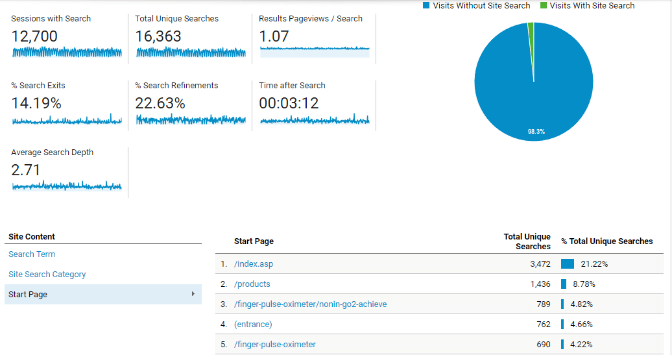My esteemed colleague Taylor Schultz recently wrote an excellent article titled, 5 Ways to Optimize Your Internal Search. Following her recommendations will provide a user-friendly tool that is more prominent, highly engaging and, best of all, yields better results and more “conversions”!
In keeping with the internal site search theme, I am going to share 5 questions your current internal site search data can help you answer.
Before we begin, if you find yourself thinking, “My website doesn’t have any internal search functionality right now,” then, by all means, get internal site search going ASAP. You’ll soon find out what you’ve been missing. (Just click here to learn more about Google’s search options. They start at just $100/year!)
Not quite convinced? Think about this:
- 45% of visitors will use site search if it is offered. That’s almost every other person on your site!
- Depending on the site’s content, many visitors actually start their site visit with the onsite search tool.
- Those who use site search tend to be more engaged and better quality visitors. This makes for a more successful site visit, which is a win-win for your visitors and for you.
By implementing internal site search and tracking this data in Google Analytics, you can tap into a wealth of knowledge. Your internal site search data helps connect the dots by answering these five questions.
1. Who is using my internal site search?
Adding secondary dimensions in Google Analytics illuminates deeper learnings quickly. In the example below, we chose Source/Medium as the secondary dimension. In this case, Organic searches stemming from Google make up the vast majority of subsequent onsite searches. We kept this view at a detailed level, but it would certainly be easy enough to change to a more summary-level view.

We can also answer other questions by swapping out different categories of Secondary Dimensions, such as:
- Age. Looking at searches by age group almost always yields some differences in online acumen. How often different age groups refine their search, as well as the specific search queries different age groups use, can shed light on where you might need to update your content to better align with your personas.
- Geography. Geographic analysis, whether regional or global, can show great insights around areas where visitors may not be using the same product or solution information as what is on the site.
- Website pages. Specific to any paid investment, looking at different pages can quickly draw attention to changes to improve both keywords and content.

2. Is post-search behavior an indication of success?
Post search behavior can be informative on multiple fronts. For example, take a look at the dashboard from Google Analytics to zero in on a few post search metrics. The percent of search exits tells us only 14% of users leave the site after performing a search, which is quite good overall. The percent of search refinements at 23% is also satisfactory for this specific client. Here, the average time after search metric is strong. Because this particular site is set up to inform, educate and provide deep research on a variety of topics, we consider spending more than three minutes on the site after a search a positive sign.

It is critical to take into account your specific website’s goals as well as the nature of your business when analyzing site search data to determine whether you’re finding success.
3. How do Search Refinements impact our success rates?
The number of times a visitor must refine a search may indicate overall visitor satisfaction with the answers they received via their search query. If they have to refine a search many times, odds are some things need to change on your site so your visitors can find what they are looking for faster. Another thing to look at is the particular search queries that lead to the greatest opportunities for success once they have been refined.
4. Just what terms are my website visitors searching on anyway?
Amazingly enough, internal site search is one of the only places one can easily get keyword data research – and it’s one of the best sources, too! When digging into this data source, many B2B businesses see very technical search queries. Other businesses might see searches around downloads, software versions, old products, old brands that no longer exist, and so on. As you can imagine, these insights are valuable for driving better content that is more closely aligned with what users are looking for.
5. How truly successful is my internal site search feature?
Does my onsite search engine lead to more sales, leads, engagement? Whatever makes the most sense for your business to measure, it’s important to know whether internal site search is helping move the needle. In the table below, we see that utilization of onsite search resulted in an additional $5,600 in revenue in just a month. This is cause enough to warrant having onsite search functioning and analyzing the data regularly.

6. How can I improve?
This is perhaps the most important question (and one worthy of its own blog post), but it is your bonus point here. 🙂
There are so many internal site search metrics to act on to improve overall user experience, boost revenue, generate leads, and so on. One area we have not yet touched on is integrating other promotional campaigns, such as email marketing, offline efforts, pdf downloads with links back to the site, just to name a few. By researching behavior data around the usage of onsite search, it’s easy to uncover ways to make improvements to all types of promotional activities.
Integrating insights from other site metrics, such as overall behavioral path analysis, also helps illuminate areas for improvement. Applying changes to sections of your site, testing the prominence of the onsite search box, or testing changes to the look and feel of the onsite search box are all great jumping off points for further gains.
Because the internal search feature on a website has practically become second nature, it’s easy to take this function and the data it provides for granted. Consider these big business questions internal site search data can answer so you don’t miss out on the opportunities at hand!
Is your site optimized for search? We can help. Take a look at our SEO capabilities.
